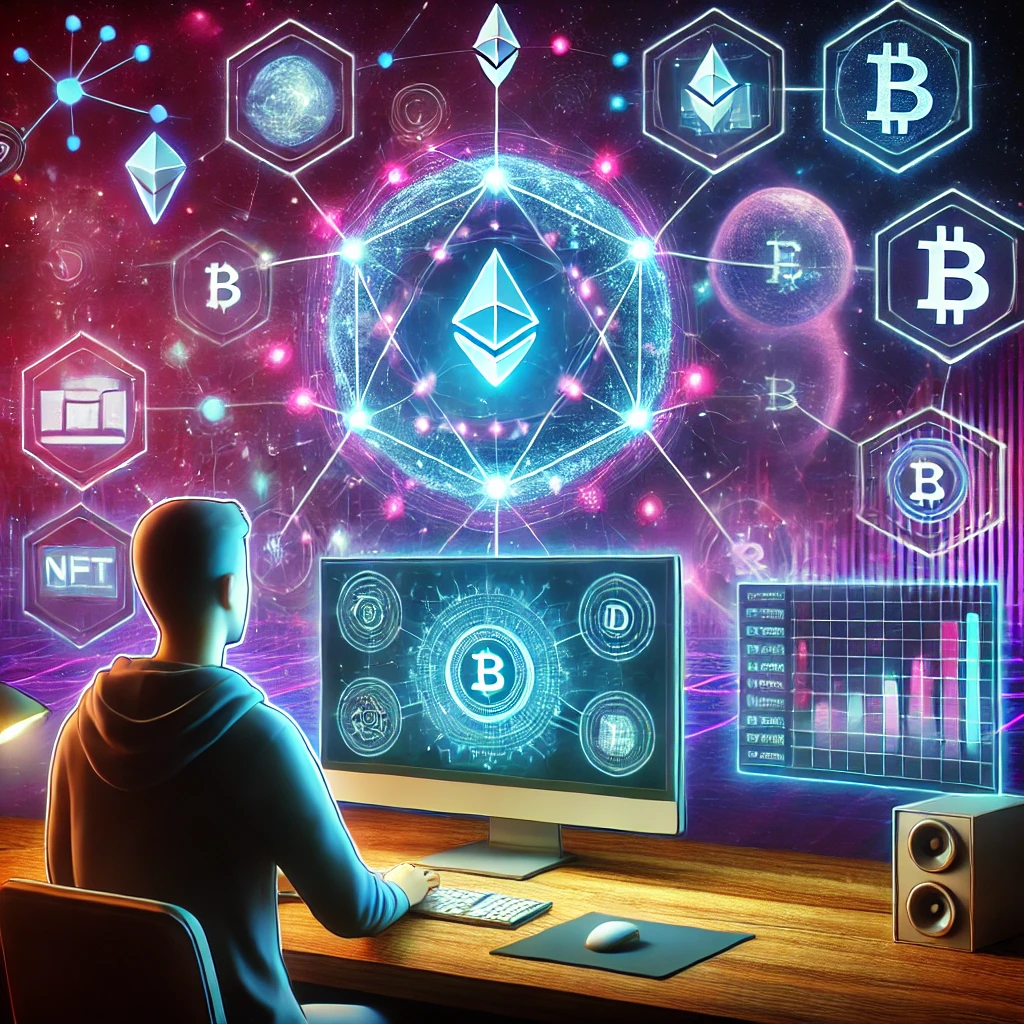Onboard yourself into Web3.
 Ayomide Aluko
Ayomide Aluko
Hi Anon!🙋🏽♂️
Web3 is blowing up, bringing with it a whole new internet that’s more transparent, user-focused, and lets you actually own your digital stuff. If you’re just now hearing about blockchain, crypto wallets, dApps, or NFTs, you’re in good company. It can feel like there’s a new buzzword every day but don’t stress. Web3 is all about putting the power back in your hands. This guide is your roadmap to diving in, from getting the basics down to making your first moves on a blockchain. Ready to explore? Make sure you finish reading this.
1. Understanding the Basics of Web3
What is Web3?
Web3 refers to the third generation of the internet that aims to create a decentralized web. Unlike Web2, which is dominated by centralized platforms like Google, Facebook, and Amazon, Web3 operates on blockchain technology, allowing for decentralized applications (dApps), where users have control over their data and assets.
Key components of Web3 include:
Blockchain: A decentralized digital ledger that records transactions across many computers.
Cryptocurrency: Digital assets used as a medium of exchange within Web3.
Smart Contracts: Self-executing contracts where the terms are directly written into lines of code.
dApps: Decentralized applications that operate on blockchain networks.
Tokens: Digital assets built on blockchain platforms, including fungible tokens like Ether (ETH) and non-fungible tokens (NFTs).
Why Web3?
Web3 promises benefits such as:
Ownership: You truly own your digital assets, unlike on Web2 platforms where data is often controlled by centralized authorities.
Transparency: Transactions on blockchain are publicly viewable, increasing accountability.
Control: You have greater control over your identity and assets without relying on third-party intermediaries.
Where to Learn more:
- Coursera: Blockchain Basics – A free course covering fundamental blockchain concepts.
2. Setting Up a Wallet
The first step to interacting with Web3 is setting up a cryptocurrency wallet. Wallets allow you to store, send, and receive cryptocurrency and interact with dApps.
Types of Wallets
There are two primary types of wallets:
Custodial Wallets: Managed by third-party services, making them user-friendly but less secure.
Non-Custodial Wallets: Fully controlled by the user, making them more secure but with added responsibility.
Most Web3 users prefer non-custodial wallets for more control. The most popular options are:
MetaMask: A browser extension and mobile app that acts as a bridge between your browser and the Ethereum blockchain.
Trust Wallet: A mobile wallet that supports multiple blockchains.
Setting Up MetaMask
Install MetaMask: Visit the MetaMask website and download the browser extension or mobile app.
Create a Wallet: Follow the on-screen instructions to create a new wallet.
Secure Your Wallet: MetaMask will provide a 12-word seed phrase—write this down and store it securely. This phrase is the only way to recover your wallet if you lose access.
Fund Your Wallet: Purchase cryptocurrency on a centralized exchange like Coinbase, Binance, or Bybit, then transfer it to your MetaMask wallet.
3. Understanding Cryptocurrency
Cryptocurrency is the backbone of Web3. Ethereum (ETH) is the most widely used cryptocurrency for Web3 applications, but other popular blockchains include Solana, Binance Smart Chain (BSC), and Polygon.
To purchase cryptocurrency:
Create an Account on a Crypto Exchange: Sign up with an exchange like Binance, Coinbase, or Kraken.
Complete KYC Verification: Most exchanges require a Know Your Customer (KYC) process to verify your identity.
Buy Cryptocurrency: Buy ETH or other cryptocurrency that you need to interact with Web3 apps.
Transfer to Your Wallet: Withdraw the crypto to your Web3 wallet by copying your wallet address and entering it on the exchange.
Network Fees (Gas Fees)
Every transaction on a blockchain requires a network fee, commonly known as a gas fee. Ethereum, for example, often has higher fees, while newer blockchains like Polygon offer lower costs.
4. Exploring dApps and Decentralized Finance (DeFi)
Decentralized Finance (DeFi) is a large part of Web3, providing services like lending, borrowing, and yield farming without traditional banks.
Popular dApps and DeFi Platforms
Some beginner-friendly dApps include:
Uniswap: A decentralized exchange (DEX) where you can swap various tokens.
Aave: A lending platform where you can lend and borrow cryptocurrency.
OpenSea: A marketplace for buying and selling NFTs.
To interact with these platforms:
Go to the dApp’s Website: Visit the site of the dApp you’re interested in.
Connect Your Wallet: Look for a “Connect Wallet” button, often located in the top-right corner. Click on it, and select MetaMask or your preferred wallet.
Authorize the Connection: Your wallet will ask you to approve the connection, allowing the dApp to view your wallet balance and make transactions on your behalf.
Explore the dApp’s Features: Start exploring the dApp’s offerings, such as swapping tokens on Uniswap or browsing NFTs on OpenSea.
5. Understanding NFTs and Digital Ownership
Non-fungible tokens (NFTs) are unique digital assets that can represent ownership of digital items, such as art, music, or even virtual real estate. Each NFT is unique and cannot be replaced by another, making them ideal for digital ownership.
Buying NFTs
To buy NFTs:
Visit an NFT Marketplace: The most popular marketplace is OpenSea. Others include Rarible and Foundation.
Connect Your Wallet: Connect your wallet to the marketplace by clicking “Connect Wallet” on the site.
Browse and Buy: Look for NFTs that interest you. To buy one, click “Buy,” and your wallet will prompt you to complete the transaction, including paying any gas fees.
Creating NFTs
If you're interested in creating your own NFT:
Visit a Marketplace: OpenSea allows users to “mint” (create) NFTs.
Upload Your File: Choose the digital file (art, music, etc.) you want to turn into an NFT.
Pay the Gas Fee: Minting usually requires a gas fee. Once paid, your NFT will be live on the blockchain and available for sale or transfer.
6. Staying Safe in Web3
Web3 is relatively new and evolving quickly, so staying vigilant is essential. Here are some tips for staying safe:
Never Share Your Seed Phrase: Your 12-word seed phrase is your wallet’s key. Never share it, even with people who claim to be tech support.
Use Strong Passwords: Set a strong, unique password for each account you create, especially your wallet and exchange accounts.
Avoid Phishing Scams: Only use official links to access dApps and exchanges. Bookmark trusted sites and avoid clicking on random links in emails or social media.
Double-Check Addresses: When transferring funds, double-check the recipient's wallet address to avoid mistakes.
Use a Hardware Wallet: For added security, consider using a hardware wallet, like Ledger or Trezor, to store your cryptocurrency offline.
7. Final Tips for Onboarding Smoothly into Web3
Stay Informed: Follow reliable sources like CoinDesk, The Defiant, or Bankless for the latest Web3 news.
Engage with the Community: Join communities on platforms like Discord, Reddit, and Twitter where Web3 enthusiasts share insights and help answer questions.
Start Small: Begin with a small amount of cryptocurrency and experiment with different dApps. As you become comfortable, you can gradually increase your engagement.
Hunt for Airdrops: This is mostly the only way you can earn in web3 without investing any money.
Web3 is an exciting evolution of the internet, empowering users to own their data, assets, and identities. By following the steps above, you’ll be well on your way to navigating the decentralized web and exploring the potential of this transformative technology.
Subscribe to my newsletter
Read articles from Ayomide Aluko directly inside your inbox. Subscribe to the newsletter, and don't miss out.
Written by

Ayomide Aluko
Ayomide Aluko
I thrive on pushing the boundaries of what technology can achieve.